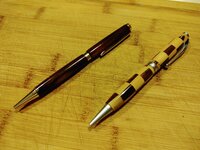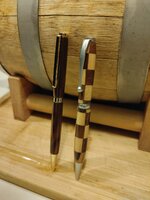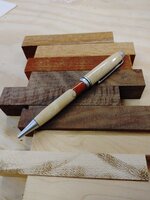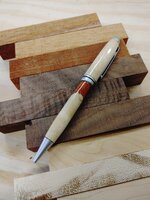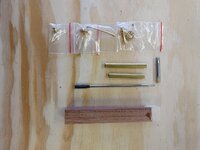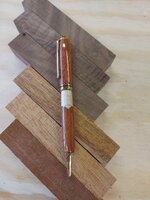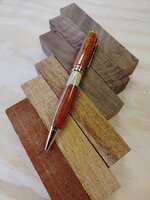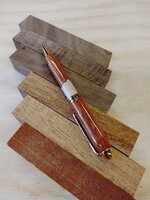Fine Engineer
Member
Hi all,
I'm new here, but already like what I see. This is similar in feel to a boatbuilding forum I used to frequent. I look forward to posting more and trading ideas with others here. I've already gotten several ideas just from looking at some of the threads.
I'm a mechanical engineer living in Carson City, NV. As a former mechanic, machinist, and all round tinkerer, I have always had a penchant for making things. Professionally, I used to make things, and now I come up with the ideas and draw the pictures that others make things from. I've made furniture for the house and done lots of home improvements as well, so I'm not new to tools and making things. This is an entirely new endeavor though.
So far, I've made 3 pens, and have noticed the 90-10 rule in clear display. That is that it takes 10% of the effort to get 90% of the results you want, and 90% of the energy to get that last 10%. My first efforts look good on the surface, but each has a flaw I'd like to learn to eliminate.
So the first one was a Slimline using the Cocobolo supplied with the kit assortment I bought. As a first effort, I could hardly expect perfection, so am happy with the result.
The second one was an experiment on several fronts. While making some blanks from wood I already have, I took some Willow, and sandwiched it with Walnut. All the sections were nearly 3/8", so I thought I'd end up turning all the Walnut off and just end up with the Willow. So I cut it up into 1/2" sections, rotated every other one, and glued it all back together. I then used a Comfort pen kit (figuring the larger diameter would work better for this), and chucked it up. One of the things I wanted to test was combining two woods of very different harnesses. The result was just fine. The Willow didn't gouge out or chip, and the result was just fine. I gave this one to my daughter who had a special attachment to the tree that I got the Willow from.
The third pen is Maple and Jatoba with aluminum separators (soda can metal) on a Satin Designer Twist kit. I need to work on my precision with these interlocking segments, but I'm very happy with the overall results. Both woods respond spectacularly to CA finish, and the feel is very nice. I'll be working on the sister to this one today, so we'll see how the inverse color scheme turns out.
Anyway, this is a decent start, and I look forward to sharing more with all of you as I progress with this.
I also need to work on my photography, as these shots are nowhere near up to the standards I've seen here. ONe thing at a time though, right?
I'm new here, but already like what I see. This is similar in feel to a boatbuilding forum I used to frequent. I look forward to posting more and trading ideas with others here. I've already gotten several ideas just from looking at some of the threads.
I'm a mechanical engineer living in Carson City, NV. As a former mechanic, machinist, and all round tinkerer, I have always had a penchant for making things. Professionally, I used to make things, and now I come up with the ideas and draw the pictures that others make things from. I've made furniture for the house and done lots of home improvements as well, so I'm not new to tools and making things. This is an entirely new endeavor though.
So far, I've made 3 pens, and have noticed the 90-10 rule in clear display. That is that it takes 10% of the effort to get 90% of the results you want, and 90% of the energy to get that last 10%. My first efforts look good on the surface, but each has a flaw I'd like to learn to eliminate.
So the first one was a Slimline using the Cocobolo supplied with the kit assortment I bought. As a first effort, I could hardly expect perfection, so am happy with the result.
The second one was an experiment on several fronts. While making some blanks from wood I already have, I took some Willow, and sandwiched it with Walnut. All the sections were nearly 3/8", so I thought I'd end up turning all the Walnut off and just end up with the Willow. So I cut it up into 1/2" sections, rotated every other one, and glued it all back together. I then used a Comfort pen kit (figuring the larger diameter would work better for this), and chucked it up. One of the things I wanted to test was combining two woods of very different harnesses. The result was just fine. The Willow didn't gouge out or chip, and the result was just fine. I gave this one to my daughter who had a special attachment to the tree that I got the Willow from.
The third pen is Maple and Jatoba with aluminum separators (soda can metal) on a Satin Designer Twist kit. I need to work on my precision with these interlocking segments, but I'm very happy with the overall results. Both woods respond spectacularly to CA finish, and the feel is very nice. I'll be working on the sister to this one today, so we'll see how the inverse color scheme turns out.
Anyway, this is a decent start, and I look forward to sharing more with all of you as I progress with this.
I also need to work on my photography, as these shots are nowhere near up to the standards I've seen here. ONe thing at a time though, right?
Attachments
Last edited:

